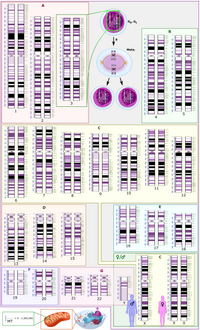
Photo from wikipedia
In the past few decades, dengue has spread rapidly and is an emerging disease in China. An unexpected dengue outbreak occurred in Xishuangbanna, Yunnan, China, resulting in 1331 patients in… Click to show full abstract
In the past few decades, dengue has spread rapidly and is an emerging disease in China. An unexpected dengue outbreak occurred in Xishuangbanna, Yunnan, China, resulting in 1331 patients in 2013. In order to obtain the complete genome information and perform mutation and evolutionary analysis of causative agent related to this largest outbreak of dengue fever. The viruses were isolated by cell culture and evaluated by genome sequence analysis. Phylogenetic trees were then constructed by Neighbor-Joining methods (MEGA6.0), followed by analysis of nucleotide mutation and amino acid substitution. The analysis of the diversity of secondary structure for E and NS1 protein were also performed. Then selection pressures acting on the coding sequences were estimated by PAML software. The complete genome sequences of two isolated strains (YNSW1, YNSW2) were 10,710 and 10,702 nucleotides in length, respectively. Phylogenetic analysis revealed both strain were classified as genotype II of DENV-3. The results indicated that both isolated strains of Xishuangbanna in 2013 and Laos 2013 stains (KF816161.1, KF816158.1, LC147061.1, LC147059.1, KF816162.1) were most similar to Bangladesh (AY496873.2) in 2002. After comparing with the DENV-3SS (H87) 62 amino acid substitutions were identified in translated regions, and 38 amino acid substitutions were identified in translated regions compared with DENV-3 genotype II stains Bangladesh (AY496873.2). 27(YNSW1) or 28(YNSW2) single nucleotide changes were observed in structural protein sequences with 7(YNSW1) or 8(YNSW2) non-synonymous mutations compared with AY496873.2. Of them, 4 non-synonymous mutations were identified in E protein sequences with (2 in the β-sheet, 2 in the coil). Meanwhile, 117(YNSW1) or 115 (YNSW2) single nucleotide changes were observed in non-structural protein sequences with 31(YNSW1) or 30 (YNSW2) non-synonymous mutations. Particularly, 14 single nucleotide changes were observed in NS1 sequences with 4/14 non-synonymous substitutions (4 in the coil). Selection pressure analysis revealed no positive selection in the amino acid sites of the genes encoding for structural and non-structural proteins. This study may help understand the intrinsic geographical relatedness of dengue virus 3 and contributes further to research on their infectivity, pathogenicity and vaccine development.
Journal Title: Virus research
Year Published: 2017
Link to full text (if available)
Share on Social Media: Sign Up to like & get
recommendations!